During my time working with bonsai I have noticed that some things come very easily whilst others are a constant battle. It’s almost like some trees find us and in time become an integral part of our lives. My experience with this English yew (taxus baccata) illustrates the point perfectly.
Every year our local bonsai club organises a collecting trip to plantation woodland not far from my home. Spring 1995 found me, my wife and dog enjoying a Sunday morning walk in the sunshine, spade in hand. However by the end of the day there was noting in the bag and the weather had taken a turn for the worst. Resigned to a fruitless day I trudged wearily back to the car. Along the way I took one last detour into a thicket in a last ditch attempt to redeem the day. After a few meters I emerged into a low clearing and right there sitting on a small hump of soil was “my” yew. The tree was laying over on it’s side, it had probably been pushed over during thinning operations of the surrounding pine trees. The little hump was covered in lush green moss and the red trunk looked spectacular in the fading light. The tree had grown an umbrella of foliage about 2 meters above the ground. We sat for some time enjoying the serene atmosphere of the place whilst I decided what to do. I had never collected a tree this big and had no real idea whether it was possible to move it successfully or even make bonsai from it. But, with a little encouragement from my better half I decided to go ahead and, in spite of woefully inadequate tools the tree came free and we all headed for home.
Once in the workshop doubt began to enter my mind. With little expectation I left the tree under a wet sack for a week in the dark before finally taking pity on it. I pushed the tree into an old wooden box and tipped in a sack of chipped bark before putting the tree outside next to the compost heap, where I figured it would end up. Much to my surprise the tree began to grow almost immediately and by the end of summer I had a large bush of green foliage.
Spring 1996, encouraged by the trees response I re-potted him into a very small plastic tub. In the process I completely washed the roots, this turned out to be the single most important part of the whole story. I then potted the tree into a VERY open mix. Again that year he grew well and by season end had 1 meter extensions. For the next few years I kept the tree in full sun, watered very well and fertilized the tree like crazy. Using copious amounts of rapeseed meal and a 30% nitrogen chemical every week, the tree was growing more than a meter a year. However I still had no clue how to make this stump into the beautiful bonsai I so desired.
As the old proverb says “When the pupil is ready the teacher appears”. In 1999 I met Kevin Willson. In spring 2000 I took the yew to meet him. Kevin’s world renowned reputation for working English yew convinced me I was in safe hands and so, having remained un-persuaded to sell, I booked a weekend to begin work on the tree.
During the latter part of May that year I spent a memorable weekend with Kevin, an experience that literally changed my life. Over two days (and a whole night) we worked like galley slaves and by the end we had our tree. I was woefully unaware of how far there was still to go but considering the sad looking old stump I dragged from the woods I was as proud as a new father. Over the following summer I lost several branches and also foolishly allowed wire to damage some of the tree quite badly. By September the tree looked in a poor state and I was worried. Over the winter I removed about 30% of the branches and also shortened the tree by 15cm (6”) in height.
Spring 2001 and my fears were allayed as the tree, once again, exploded with new growth. All summer I allowed the tree free reign and returned to the heavy feeding regimen. That autumn I completed the first of many late night carving sessions. I estimate that since that first workshop I have expended more than 50 hours creating and refining the trees deadwood areas. It’s now completely hollow. Today with more experience I would perhaps have done things differently but I do like the stylized look of the tree and expect him to remain like this for as long as we are friends.
2002 saw the tree go into a slightly oversized Bryan Albright pot. Some wiring and more carving was completed and by mid summer I felt quite proud of the tree, sufficiently so I decided to offer it for selection to the prestigious Ginkgo Awards 2003. Once at the event I felt a little embarrassed and intimidated by the stunning trees already in attendance. However, and much to my delight the tree was chosen and we went home elated. Over the following year I worked and schemed and worked some more to make the tree the best I possibly could for the coming exhibition, I even made the display table myself. Being a part of an event like the Ginkgo awards is a great experience and whilst I was a little unhappy with how immature the tree appeared at the show I was content just to be there.
Another significant event occurred on the way out of the exhibition when Danny Use told me “Now you have to go home and make the tree even better”. Being a simple fellow and respecting Danny’s experience I did just that.
Spring 2007 saw the tree planted in a very beautiful Gordon Duffet pot. Being small it makes the tree look even more imposing than before and sets the tree off to perfection.
After 13 years my experience has developed as much as my yew and I now look at the tree with a critical eye and see many faults and areas needing improvement, particularly in balancing the vigour of the foliage as some areas remain a little weak. Every year I make a plan to improve the tree and every year the tree responds to the love and care I give it. In the last pictures the tree has no wire, just a couple of ties. In fact I have only wired this tree twice to date. I continue to feed the tree very well and it continues to grow strongly making three breaks of growth every year.
I once read that Taxus was slow to develop as bonsai which is obviously not so. However, among the many lessons I have learned from this tree, the most significant is that in order to be successful we must take absolute control over every influence of the tree, watering, feeding, sunlight, soil etc’, and craft these into an ideal environment for our material to thrive. It’s impossible to develop an unhappy tree into bonsai. A sickly tree will be a constant frustration to us before we ultimately fail.
If I had to make up some rules for cultivating bonsai the first would be…
ALWAYS PUT THE HEALTH OF THE TREE FIRST!
The second rule would be…
ALWAYS PUT THE HEALTH OF THE TREE FIRST!
The third rule would be…
TAKE YOUR TIME. IT’S THE FASTEST WAY TO ACHIEVE YOUR GOAL.
So looking back over 13 years I still find it hard to believe that ratty old stump became a beautiful bonsai. There have been a few scary moments, some sleepless nights, a lot of hard work and head scratching. The final result is the sum of many influences as I have already mentioned. Chief of all these is the tree itself. Way back in the gloaming of it’s woodland home I believe IT wanted to be beautiful.
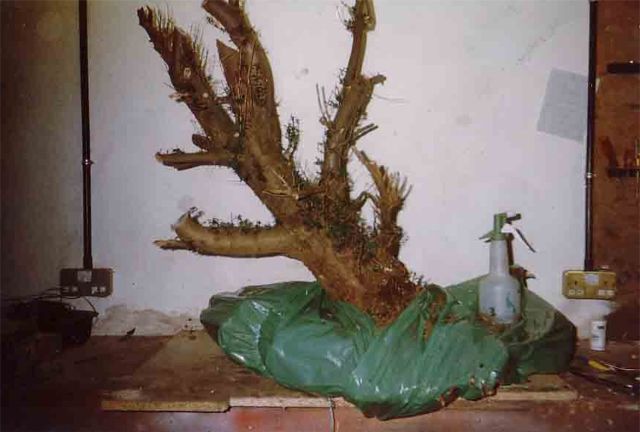
Collected from local woodland I had absolutely no idea what to do with this massive yew back in 1995.
By 1999 the tree had grown spectacularly.
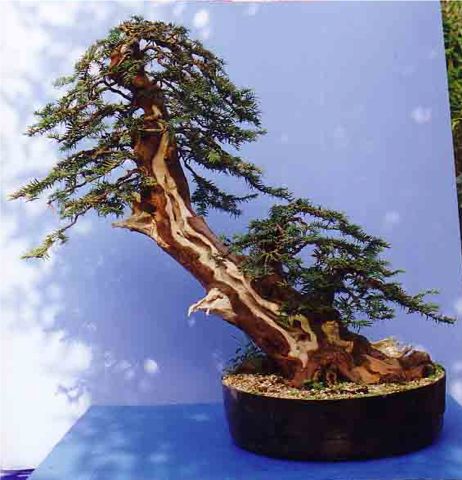
Following 2 very intensive days with Kevin Willson this is how the tree looked in summer 1999.
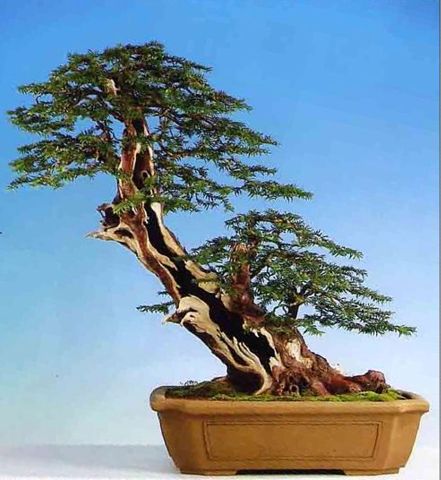
2002. Following untold hours of carving, branch thinning, rewiring and a repot into this lovely Bryan Albright pot I think this is a very convincing image. The tree is much shorter than the previous image (now 32″) and the carving is extremely deep and breaks right through the trunk in several places. By 2003 the new growth of foliage will increase the branch density and complete the image.
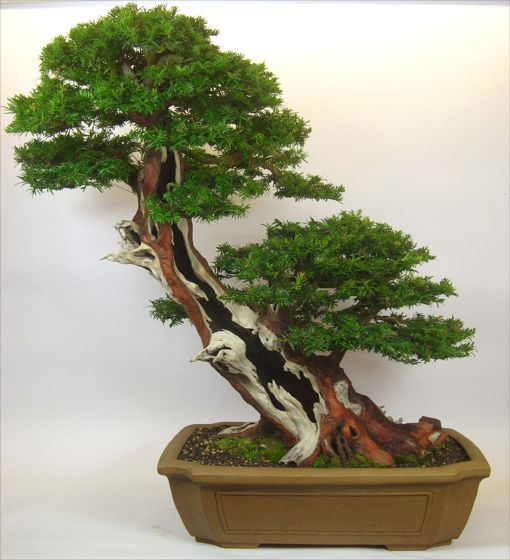
The tree as shown at BUKEX 2006.
There is still a long way to go in defining the foliage pads and increasing density. Also a new Gordon Duffett pot is on the way. Apart from a few guy wires the tree is now completely self-supporting and has only been wired twice thus far. Even though I have taken this tree every step of the way I still can hardly believe what a beautiful Bonsai grew from that useless old stump just a few years back.
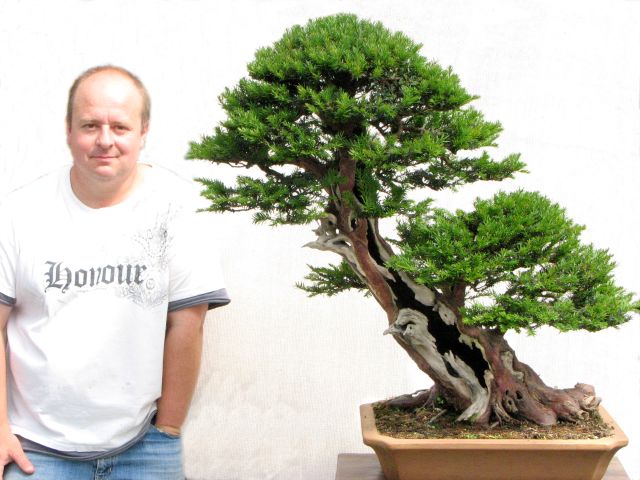
Beauty and the Beast
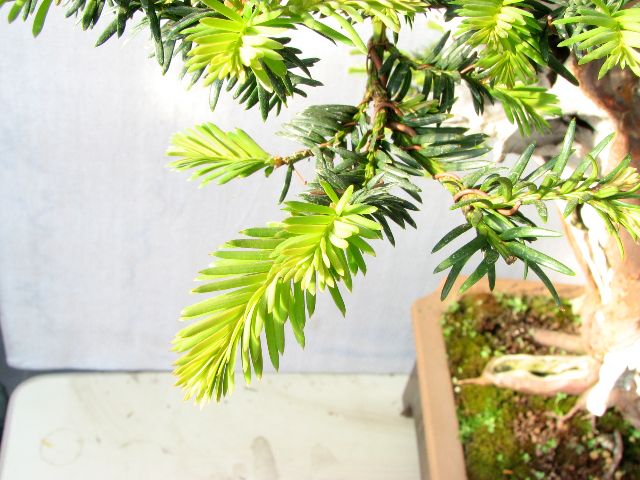
New spring growth at about 25mm ready for pinching.
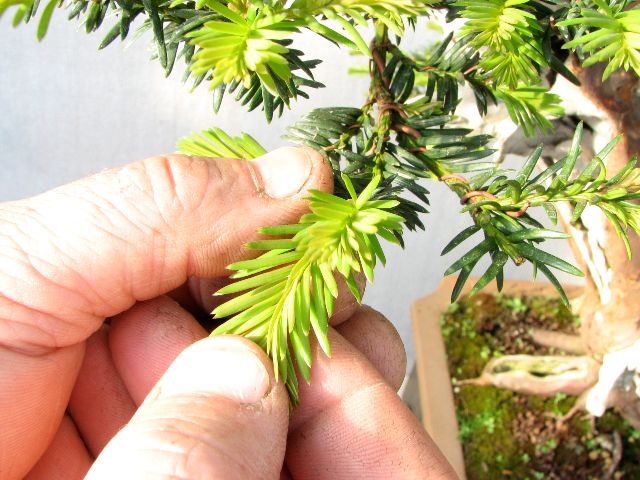
Just pinch the first quarter of the new shoot.
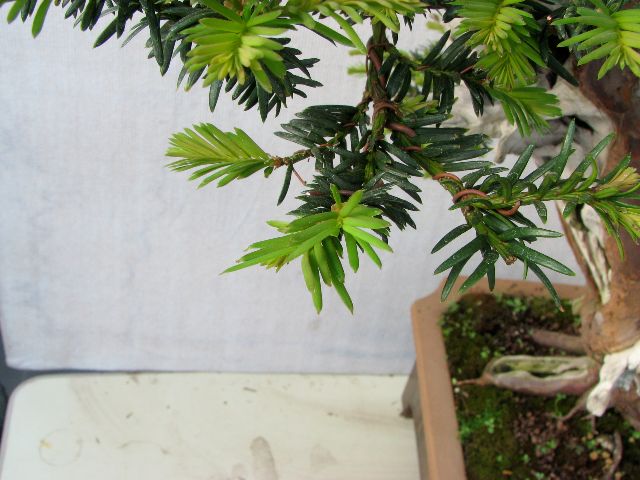
Complete. Leave the weaker shoots to develop further.
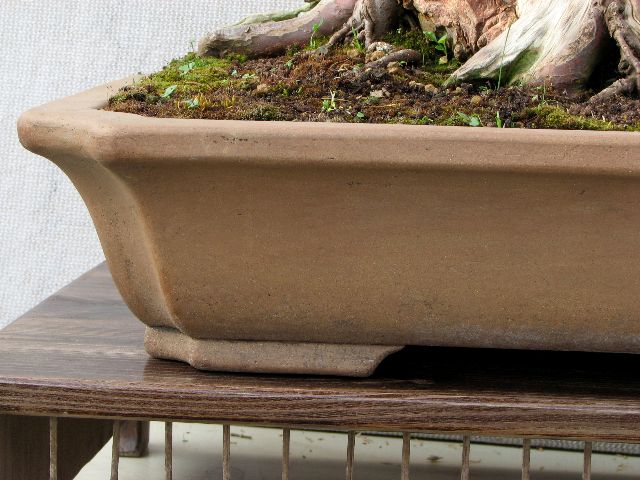
Detail of the beautiful pot. Gordon Duffet is a master!
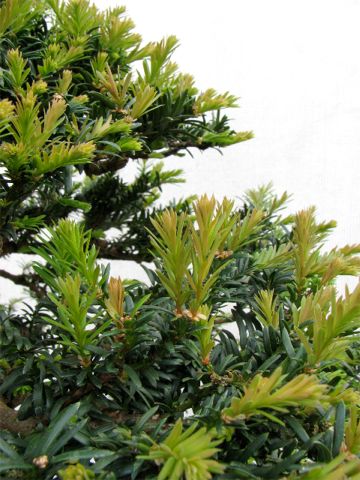
In time, with regular pinching all the new growth will become
vertical. Notice the difference between upright and horizontal shoots.
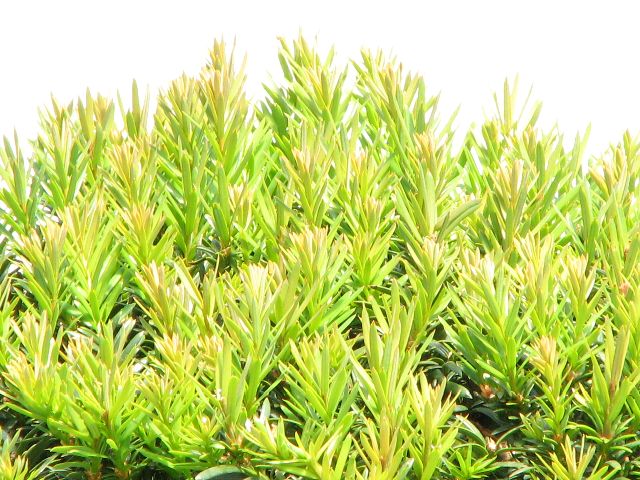
All vertical shoots. The bonsai approaches maturity.
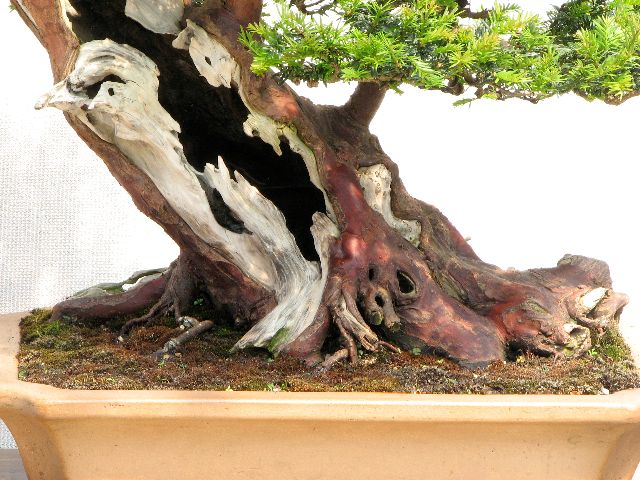
Trunk detail
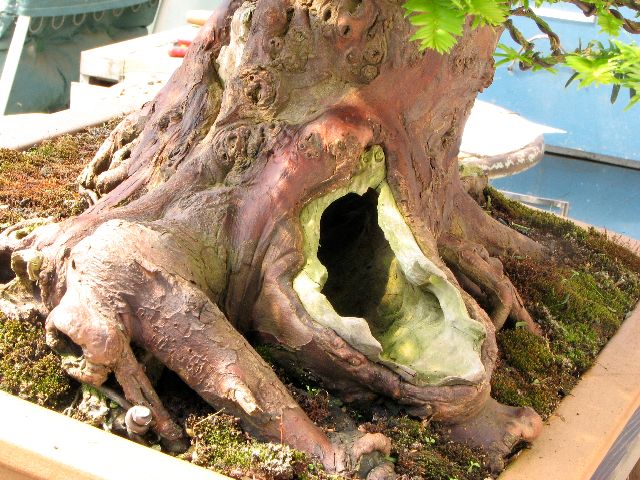
Trunk from the back. The tree is completely hollow.
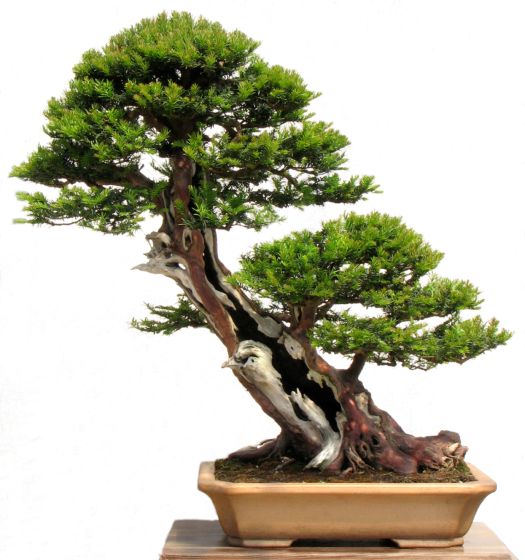
Spring 2008. After pinching and in it’s smart new Gordon Duffet pot.
Graham Potter
www.kaizenbonsai.com
